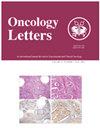Daratumumab‑resistant multiple myeloma with extramedullary disease successfully treated with combination elotuzumab, pomalidomide and dexamethasone: A case report.
IF 2.2
4区 医学
Q3 ONCOLOGY
引用次数: 0
Abstract
Despite the emergence of monoclonal antibodies, the prognosis of patients with multiple myeloma (MM) with extramedullary disease remains poor. The present report describes a rare case of daratumumab-refractory MM that was successfully treated with elotuzumab, pomalidomide and dexamethasone. A 66-year-old male patient diagnosed with MM was treated with bortezomib, lenalidomide and dexamethasone, followed by high-dose chemotherapy and autologous stem cell transplantation. Thereafter, the patient was treated with lenalidomide and dexamethasone as maintenance therapy. This was changed to daratumumab, bortezomib and dexamethasone when new paraskeletal lesions were identified, resulting in marked tumor shrinkage. After 15 months, an increase in serum monoclonal protein levels, development of a skeletal lesion in the right second rib and extramedullary disease of the right thoracic mediastinal lymph nodes were noted. Treatment with elotuzumab, pomalidomide and dexamethasone (EPd) resulted in expeditious symptomatic improvement and regression of the lesions. Notably, during daratumumab, bortezomib and dexamethasone treatment, lymphocyte counts gradually increased to a level at which elotuzumab was sufficiently effective. EPd might be a promising strategy for the treatment of patients with relapsed extramedullary MM while on daratumumab treatment.埃洛珠单抗、泊马度胺和地塞米松联合疗法成功治疗达拉单抗耐药的多发性骨髓瘤髓外疾病:病例报告。
尽管出现了单克隆抗体,但伴有髓外疾病的多发性骨髓瘤(MM)患者的预后仍然很差。本报告描述了一例罕见的达拉曲单抗难治性多发性骨髓瘤病例,该病例成功接受了艾洛珠单抗、泊马度胺和地塞米松治疗。一名66岁的男性患者被诊断为MM,接受了硼替佐米、来那度胺和地塞米松治疗,随后进行了大剂量化疗和自体干细胞移植。此后,患者接受来那度胺和地塞米松作为维持治疗。在发现新的寄生虫病变后,改为达拉单抗、硼替佐米和地塞米松治疗,结果肿瘤明显缩小。15个月后,发现血清单克隆蛋白水平升高,右侧第二根肋骨出现骨骼病变,右胸纵隔淋巴结出现髓外病变。使用艾洛妥珠单抗、泊马度胺和地塞米松(EPd)治疗后,患者症状迅速改善,病变消退。值得注意的是,在达拉单抗、硼替佐米和地塞米松治疗期间,淋巴细胞计数逐渐增加到艾洛妥珠单抗足够有效的水平。对于正在接受达拉土单抗治疗的髓外复发 MM 患者来说,EPd 可能是一种很有前景的治疗策略。
本文章由计算机程序翻译,如有差异,请以英文原文为准。
求助全文
约1分钟内获得全文
求助全文
来源期刊

Oncology Letters
ONCOLOGY-
CiteScore
5.70
自引率
0.00%
发文量
412
审稿时长
2.0 months
期刊介绍:
Oncology Letters is a monthly, peer-reviewed journal, available in print and online, that focuses on all aspects of clinical oncology, as well as in vitro and in vivo experimental model systems relevant to the mechanisms of disease.
The principal aim of Oncology Letters is to provide the prompt publication of original studies of high quality that pertain to clinical oncology, chemotherapy, oncogenes, carcinogenesis, metastasis, epidemiology and viral oncology in the form of original research, reviews and case reports.
 求助内容:
求助内容: 应助结果提醒方式:
应助结果提醒方式:


